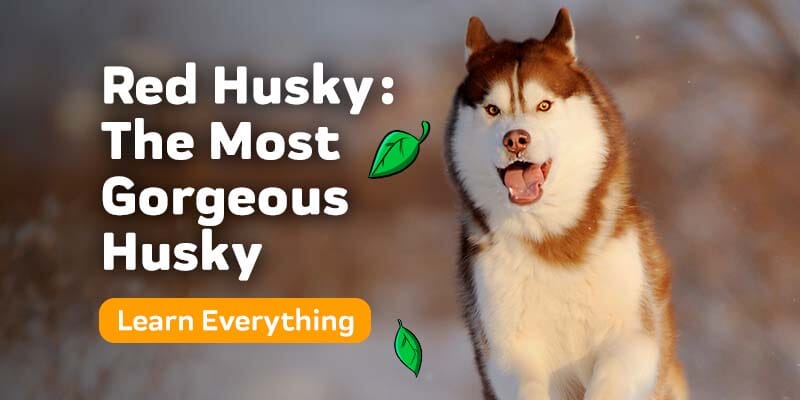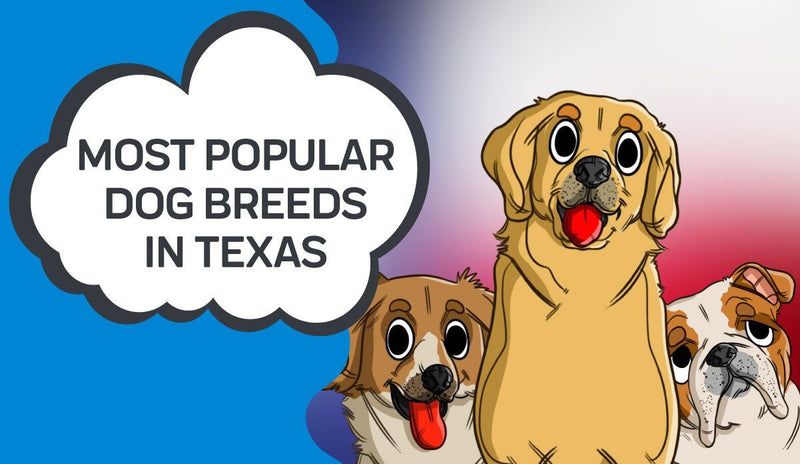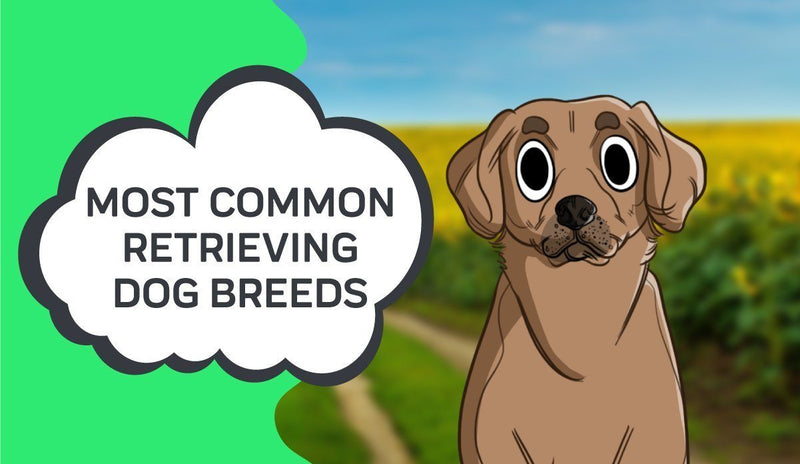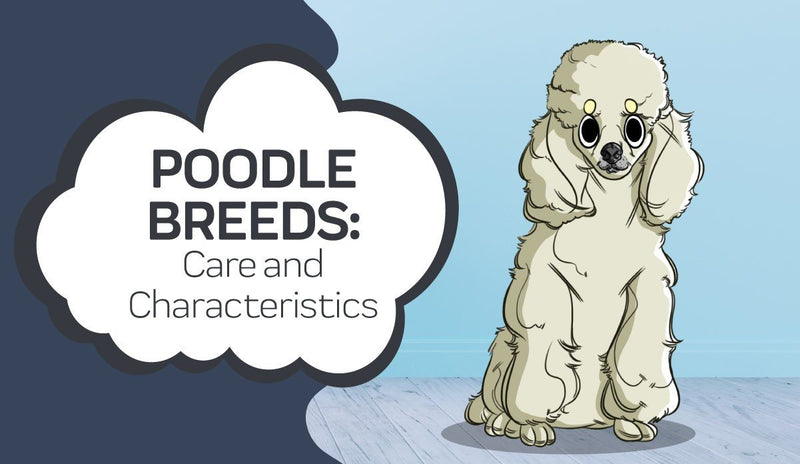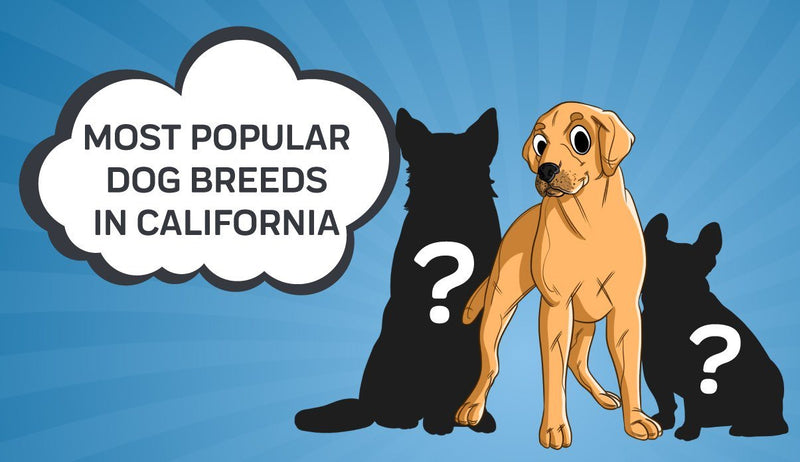
Everything You Wanted To Know About The Red Siberian Husky
If I asked you to think about a Siberian Husky, what’s the first thing that comes to mind?
Like many people, you probably think about how gorgeous and majestic the Siberian Husky is. It might be their icy and piercing blue eyes that you think about first, or perhaps you think about how the Siberian Husky closely resembles the wild wolf.
Siberian Huskies are certainly flashy-looking dogs, and that’s why we’re talking all about the flashiest of the Siberian Husky, the red Husky.
We’ll look into whether they have a different personality from their black and grey counterparts. We’ll find out if the rarity of the red coat leads to health issues. As well, we’ll give you our favorite tips for training a Siberian Husky.
So let’s find out if a Siberian Husky puppy is in your future.
Fast Facts On The Red Siberian Husky
|
Breed |
Siberian Husky |
|
Other Names |
Chukcha, Husky, and Sibe |
|
Breed Type |
Purebred |
|
Lifespan |
12-15 years |
|
Height |
Female: 20–22 inches (50–56 cm) >Male: 21–24 inches (54–60 cm) |
|
Weight |
Female: 35–51 lbs (16–23 kg) Male: 44–60 lbs (20–27 kg) |
|
Health Concerns |
Hip Dysplasia, Cataracts, Progressive Retinal atrophy, Corneal Dystrophy, and Bloat |
|
Coat Type |
Thick double coat outer coat |
|
Coat Appearance |
Short-Medium, Dense, Fluffy |
|
Coat Colors |
White, Black, Piebald, Agouti, Black & Tan, Sable, Copper, Black & White, Splash, Silver, Grey, Brown, Red |
|
Grooming |
High |
|
Shedding |
Heavy — all year-round |
|
Tolerance to Temperature |
Handles extreme colds; has difficulty with extreme heat |
|
Training |
Medium-Hard |
|
Good with Other Dogs |
Yes |
|
Good With Children |
Yes |
|
Good With Cats & Pets |
Ok, Needs early training and socialization to break hunting drive |
|
Barking |
Rare / Occasionally Howls |
|
Suitable for an Apartment |
No |
|
Preferred Home |
Family with a large yard |
|
Roaming |
High |
|
Hypoallergenic |
No |
|
Suitable for First Time Dog Owners |
No |

Origins of the Siberian Husky
First, let’s get a big thing out of the way!
It’s important to know that the red Husky is not a separate breed from other purebred Siberian Huskies. Siberian Huskies come in many different color patterns as you’ll see. As well, they all have a similar personality, which is intelligent, goofy, energetic, and stubborn.
The red and white coat instead of the traditional black/grey and white coat is simply due to a recessive gene that’s been in these dogs’ lineage for thousands of years. Speaking of such, let’s find out the origins of this majestic breed.
The Siberian Husky originated in Northeast Asia around 4,000 years ago and was first bred by the Chukchi people for protection. It wouldn’t be until a thousand years later when the Husky became known as a sled dog.
3,000 years ago, Siberia’s environment changed and became extremely cold. When this happened, reindeer were forced to travel great distances for food, which in turn, forced the Chukchi people to do the same as reindeer were a major food source. As you can guess, the Chukchi people starting using their dogs to pull sleds during hunts. The Siberian Huskies ability to protect, hunt, and pull sleds for miles made them an irreplaceable member of Chukchi society.
Thousands of years after that in 1908 they made their way to Alaska where they became sled-racing dogs. Siberian Huskies share a close lineage with the Alaskan Malamute who both originate from the Taymyr Wolf that once roamed North Asia.
The Siberian Husky’s Look
Siberian Huskies are known for their wolf-like appearance with sharp upright ears and a long nose. Their tails ploof out and curl around their backs when they’re excited, which is quite often.
Black and white is the most common coat color we associate with the Siberian Husky, but they actually come in a wide range of colors: red, grey, sable, brown, piebald, and all-white.
The red Husky’s coat comes in different shades of red from a robust burgundy to a light beige. They will often be tinges of greys and blacks in their coats as well.
Of course, besides their infamous coat, there is their sharp and often icy blues eyes. There is no link between certain eye colors and coat colors. The Red Coat Husky can have green, brown, blue, or a heterochromia blend.
Interesting Fact: In some dog breeds blue eyes is a result of the merle coat pattern gene, which causes severe health problems. Fortunately, for the Siberian Husky, their blue eyes are a result of a separate gene that causes no health issues.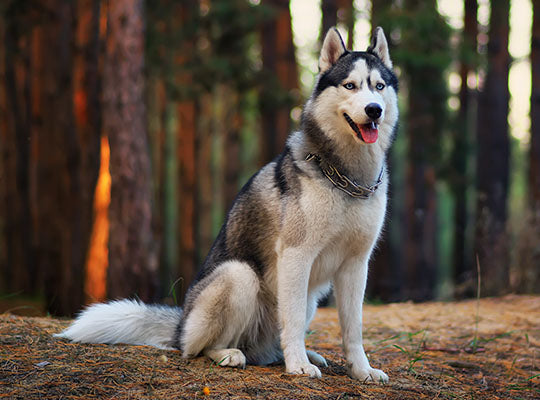
Shedding And Grooming Needs
Siberian Huskies are known as big-time shedders, and the red Husky is no different. You’ll want to peruse google search for a while to make sure you’re prepared the amount of hair that comes out when brushing.
Unlike their close cousin the Malamute, Siberian Huskies typically shed all year round. Even better, they will have a “blow out” session once or twice a year where they get rid of their undercoat. This usually happens around major seasonal changes.
You don’t have to bathe Siberian Huskies any differently than dogs with a single coat, but we recommend you use a dog formulated shampoo, so you don’t strip out the oils in their coat.
Interesting Fact: While you sometimes see people shave or clip their Husky’s coat, you never want to do this. Dogs, especially those with big coats like the husky, rely on their coats to regulate their body temperature. That big coat actually cools them down!
Red Husky Size
Siberian Huskies are a medium to large size dog breed The weigh between 30-65 pounds and stand 19-24 inches at the shoulder. They’re about half the size of their counterparts the Malamute.
Temperament Of The Red Husky
Like all Huskies, the red Husky has a big personality that often gets them in trouble. They’re outgoing to put it lightly, often mischievous, quickly get bored, and love running and escaping.
They’re wicked smart and love testing your boundaries to see what they can get away with. However, all that intelligence and energy makes them fantastic as work dogs.
They howl instead of barking, which draws the comparison to wolves even more. They also have an affinity for making weird talking noises, often sounding like Wookies. With a little training, a large fenced-in yard, and patience, Siberian Huskies make for one of the best dogs you could ever hope to have.
We can’t state enough how big and fun their personalities are; they’re big comical dork with a good dose of stubbornness. If you mixed a cat and dog together, you’d get a Siberian Husky.
Are Siberian Huskies Good Family Dogs?
Siberian Huskies have a great reputation as family dogs. They love being around other dogs due to their pack mentality, and they’re very tolerant of children. You’ll want to watch them around smaller animals like cats because besides being bred for pulling sleds, they were bred to hunt.
But while they have a prey drive, with proper training and early socialization around small creatures, the Husky can get along well with everyone.
Due to their pack mentality and high energy needs, Siberian Huskies typically due better in family households. Because of the above reasons, and the fact that a big fenced-in yard is recommended, Siberian Huskies are not recommended for single people living in the city.
Do Red and White Siberian Huskies Bark?
Siberian Huskies howl instead of bark allowing them to be trained as watchdogs that will howl when something is up. Though they make extremely poor guard dogs as they instantly fall in love with strangers.
Siberian Huskies are very talkative, but fortunately, they enjoy communicating with you at an appropriate noise level.
How Smart Are Siberian Huskies?
Without a doubt, the Husky is one of the smartest dogs around. All most too smart, you could say as they’re easily bored and love testing your patience.
Another reason they are almost too smart is that while they can quickly learn commands, they don’t always like following them. As well, getting them to focus can be difficult if there is any excitement happening around you.
However, they’re not the worst dog to teach commands. As a fact, they fall somewhere in the middle of purebred dogs that do well with command training.
Training Your Red Husky
The Siberian Husky is headstrong and intelligent, and the red Siberian Husky is no different. This makes training not the easiest, but certainly not the worse.
While huskies are stubborn, their intelligence tells them when they need to actually obey. But for this to happen, training should start soon.
When trained, you’ll have a gentle, loving, and affectionate dog that will, for the most part, listen to you. If you don’t train them, you’re going to be in for a bad time. Huskies can be destructive due to all that energy, and they will constantly test your boundaries and leadership. Do not budge, because they will remember!
We created a list of training tips that will greatly assist you when training a Siberian Husky.
Training Tips For Siberian Huskies
- Establish that you’re the leader, not them.
- Don’t yell or get violent; praising good behavior and using the occasional stern ‘no’ goes way farther.
- Reward good behavior with treats and make this the only time they get human food for the first year or two.
- Keep up with daily training, especially for the first two years.
- Make sure they are getting in at least 30 minutes of exercise before training.
- Crate training is your best friend and Huskies do very well with it.
- Set the ground rules early and do not budge because they will remember!
The Siberian Huskies Exercise Needs
However much time you can dedicate to exercising your red Husky the better. Now, of course, they do have a limit, but if they’re not pulling a sled through treacherous snow for hours, then you’re unlikely to hit their limit.
They love running, exercising, swimming, you name it. If you’re an active person that wants an active dog then look no further.
Lifespan and Health
Siberian Huskies have a considerably longlifespan for a medium to large dog. They can typically live 12-16 years, which more closely resembles the lifespan seen in smaller dog breeds.
One of the biggest things that contribute to their long lifespan is their ability to maintain a clean bill of health. Like all dogs, there are some genetic diseases their at risk for — mostly eye-related — but for the most part, they’re considered one of the healthiest dog breeds around.
Bloat
Bloating happens when gas fills the stomach and intestines, and in severe cases, it can twist them around. If left untreated, it can kill your dog!
It typically occurs in dogs when they eat a big meal then exert a lot of energy by running, exercising, etc. Because Huskies love running around at full force all the time, bloating is seen more often in their breed.
The simple way to prevent bloating is to feed smaller food portions and wait an hour before exercising or playing with them.
Hip Dysplasia
Whenever you're looking at health issues for any large dog, you’ll almost always see hip dysplasia listed. Bigger dogs do a considerable amount of growing in their first year compared to small dogs, and if their nutrition is lacking, it can lead to bone improperly developing.
Hip dysplasia can occur at any age but is typically not seen until the dog reaches middle age.
Cataracts
About 1 out of 10 Siberian Huskies develop cataracts in their life which can lead to blindness. Cataracts typically occur between 6 and 12 months of age.
Progressive Retinal Atrophy
Like cataracts, Siberian Huskies are genetically at risk for Progressive Retinal Atrophy, which can also lead to blindness. The earlier they’re diagnosed with the disease, the better for helping them retain their eyesight and keeping medical bills down.
Corneal Dystrophy
Less common than the above eye diseases is Corneal Dystrophy. It first appears as a white dot in the cornea, which can grow over time. This can lead to hazy vision, and unfortunately, there is no current treatment for it.
Taking Care Of Your Siberian Husky’s Health With CBD Oil

Like all dogs, if you want your Siberian Husky to live a long healthy life, you’ll want to make sure you’re caring for their health day-to-day. We already learned why a nutritional diet when they’re young is essential to preventing hip dysplasia, but we wanted to offer another great way you can care for their health.
More and more dog owners are finding that CBD is an essential aid for keeping their dog’s health in tip-top shape. You’ve likely heard about CBD for people because it helps with anxiety, allergies, pain, inflammation, and even cancer treatments. CBD for dogs is no different.
You can use this all-natural awesome herb for preventive health as it supports their immune system and other regulatory systems for better health on a cellular level. Or you can use it for one of the above reasons, like anxiety which huskies are prone to developing if they are left alone by themselves. Read more about how CBD can help your Siberian Husky.
How Much Do Red Huskies Cost?
If you choose to go with a breeder, you’ll want to make sure you go to a reputable breeder. One great thing by going with them is you’ll get a history on the puppy’s parents, grandparents, and their health.
When looking for a reputable breeder, you should look for the following qualities:
- Willing to take the puppy back if it doesn’t work out
- Proof of pedigree
- Parents have been screened for genetic health issues
- Puppies are up-to-date on their vaccinations
When purchasing from a reputable breeder expect to pay $500+ for a red Siberian Husky.
If you wish to rescue instead, there are a number of Siberian Husky specific rescues such as Free Spirit Siberian Rescue. A simple google search for “Siberian Husky Rescue in [your state]” is your best bet. As well, you can always try your local shelters. Typically adoption fees are $100-$300.
When you’re looking for a specific red Husky look, your best bet is adopting a pup that’s a year or older.
Is The Red Husky Right For Me?
The Siberian Husky is truly one of the greatest dogs you could ever hope to have. They’re intelligent, strong, and have huge personalities. However, they are not easy dogs and should be avoided unless you can handle certain things.
They love to run. Ok, let’s say that again. Are you prepared to bolt down the street after your Siberian Husky at the drop of a dime because they saw an opening when you were bringing groceries in? Because every Husky owner has had something like this happen to them.
But when you can give them a big yard, lots of exercise, and have trained dogs in the past then you have a truly special dog on your hands. There is nothing quite like having a Siberian Husky for a dog!










